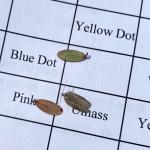Upright Dieback (UDB) continues to rule the day. Orangey-brown dead uprights scattered throughout the greening up vine is an indication of this fungal disease at work. Pictures below show this damage on Stevens and Early Black. All the samples we received with typical UDB symptoms tested positive for UDB pathogen (Phomopsis vaccinii) in lab plating. The treatment window, bud break to bud expansion, is still a week or two away. Chlorothalonils and copper fungicides are registered for UDB. If you observe typical symptoms of upright dieback on 5% or more of the uprights, please get it diagnosed by Leela Uppala.
The window for Zeus applications is closing, or in many cases, it is now too late. As cranberry buds approach cabbage head and bud scales start to spread apart, they become increasingly susceptible to injury from Zeus. Application should be made before cabbage head. Assess the bud development on your bog. Late applications can cause stunting (delayed upright growth, reduced upright growth) and in some cases reduce yields.
A few cranberry weevils were detected on a bog, but no little other insect activity has been seen. With the cooler rainy patterns we are in, it will be important to get out and sweep when/if we have that sunny >70 degree weather window. We expect winter moth numbers to be remarkably low, and gypsy moth too, but black-headed fireworm may soon be hatching. Early detection is key to best management. Yellow-headed fireworm moths (grey winter phase, pic below) were seen on State Bog this week although we held a flood in December. As few growers held significant winter floods, we may see a resurgence of this insect (and is indistinguishable from Sparganothis as larvae). Scale spots will be easiest to spot as we green up, so have an eye to dead spots and orangey round dieback areas.
The overcast, rainy weather has given us a nice break from frost despite climbing tolerances.
 Upright Dieback on ST late April
Upright Dieback on ST late April
 Upright Dieback on EB late April
Upright Dieback on EB late April
 Yellow-headed fireworm moth, netted late April
Yellow-headed fireworm moth, netted late April
In cooperation with the Cape Cod and Southeast Massachusetts Rabies Task Force, the USDA is continuing to support the Cape Cod Oral Rabies Vaccine Program to help reduce and prevent the reintroduction of raccoon rabies on Cape Cod. The Cape Cod ORV Program, which began in 1994, is praised as one of the longest running, increasingly successful projects to control rabies in the country. The Spring round of ORV baiting is set to begin the week of May 3. The distribution of Oral Rabies Vaccine baits north and west of the Cape Cod Canal will resume May 3. Approximately 68,000 baits will be distributed in portions of Mainland Barnstable and Plymouth Counties by helicopter. A low-flying red and black helicopter may be seen from May 3-8 distributing baits in Bourne, Sandwich, Wareham, Plymouth, Carver, Kingston, Middleboro, Lakeville, Rochester, and Marion. Baits will only be placed in wooded areas, wetlands, and other areas where raccoons frequent – yards, schools, open cranberry bogs, and farm fields will be avoided. Bait stations will be also be used in several Mainland areas not baited by helicopter.
Distribution of approximately 12,000 ORV baits south and east of the Canal will begin Monday, May 10. These baits will be distributed from the Cape Cod Canal through Routes 151 in Falmouth, 28 and 149 in Barnstable in an effort to boost wildlife rabies vaccination rates and prevent the reemergence of raccoon rabies there. Beginning May 10, baits will be distributed in areas of Cape-side Bourne & Sandwich, Falmouth, and Barnstable by vehicles, train, and bait stations.